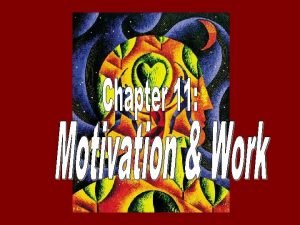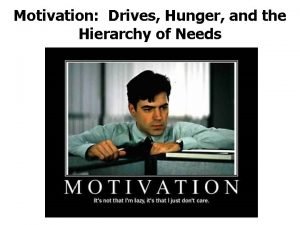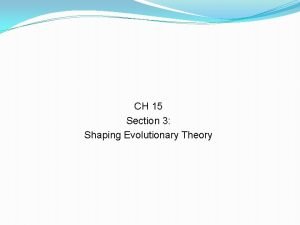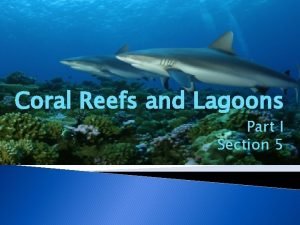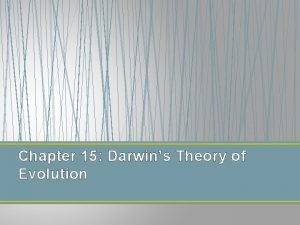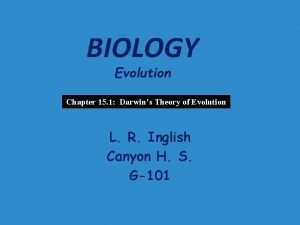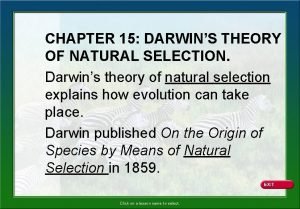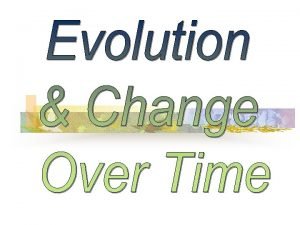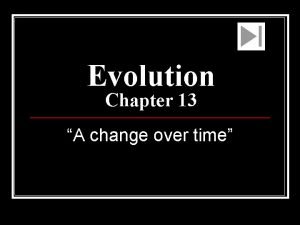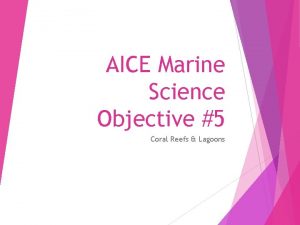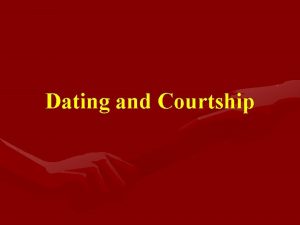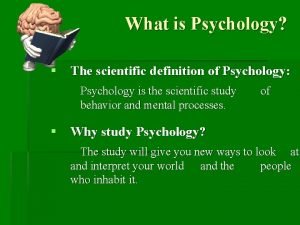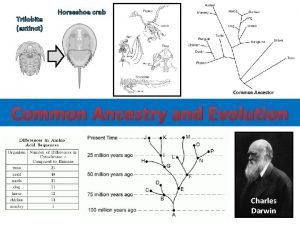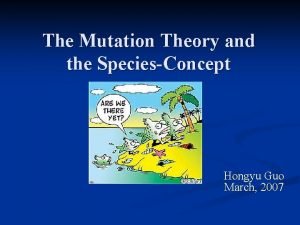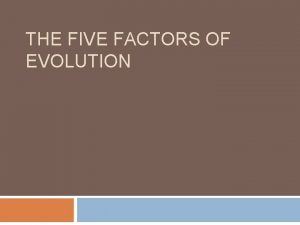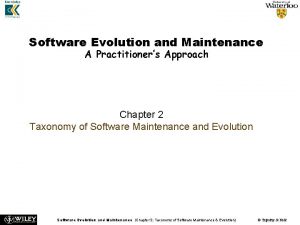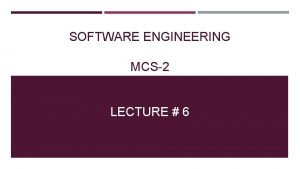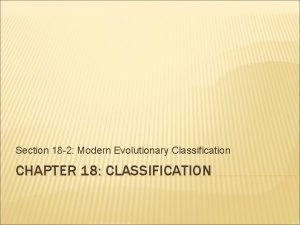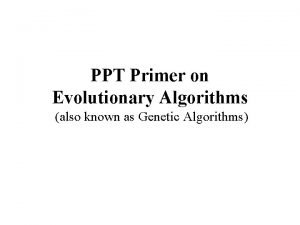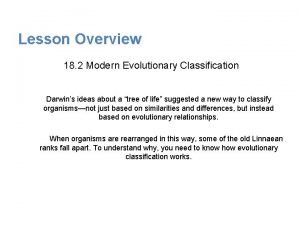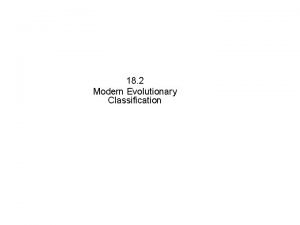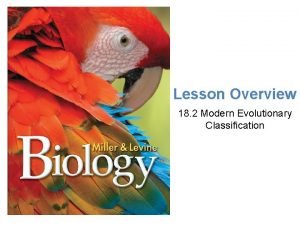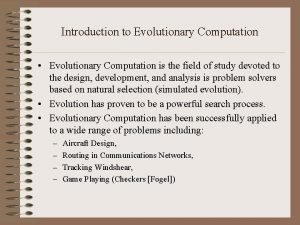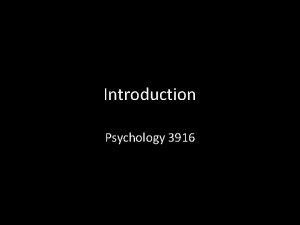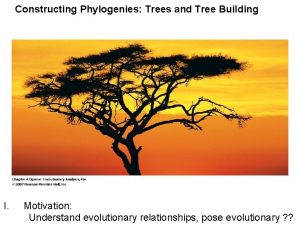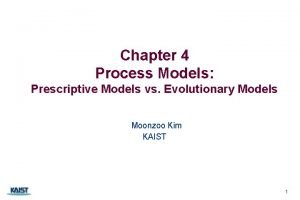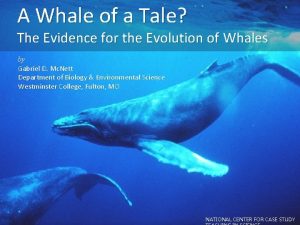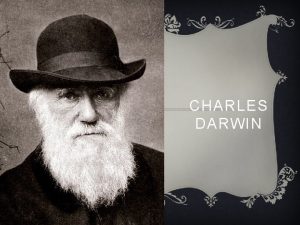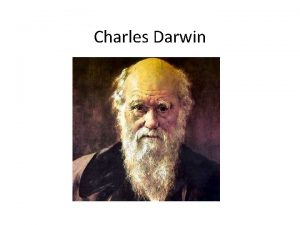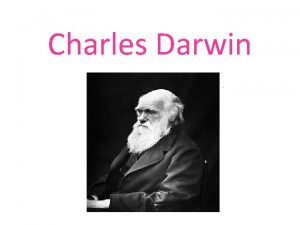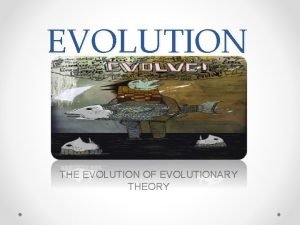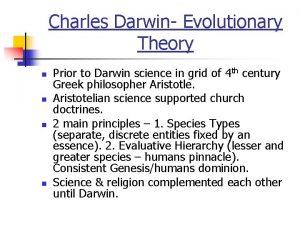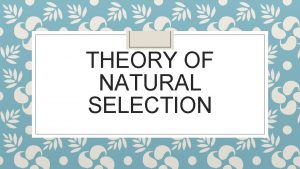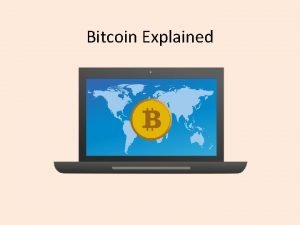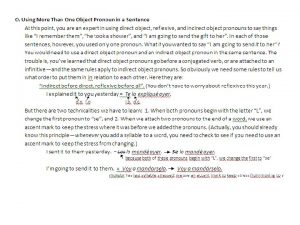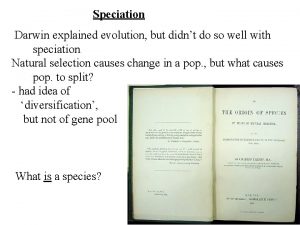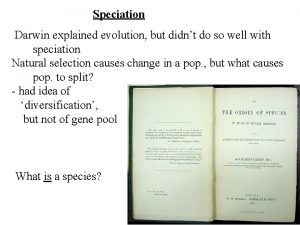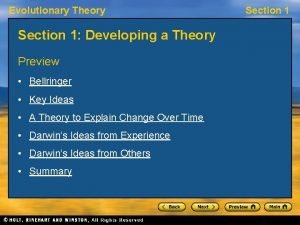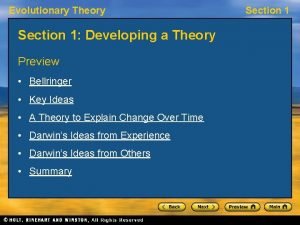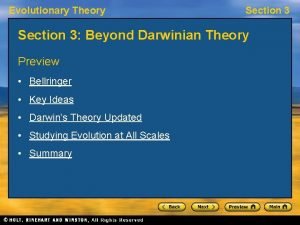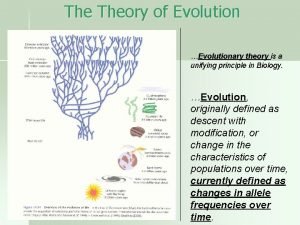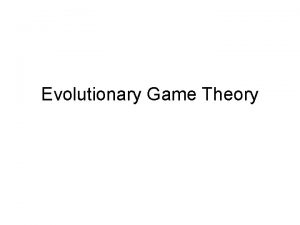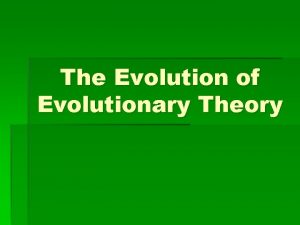Evolutionary Theory What Darwin Explained What Darwin Explained









































- Slides: 41

Evolutionary Theory What Darwin Explained

What Darwin Explained • Darwin presented a unifying explanation for data from multiple fields of science. • Today, those fields include geology, geography, ecology, developmental biology, anatomy, genetics, and biochemistry. • Scientists continue to draw on the power of Darwin’s explanations.

Evidence of Evolution • Scientists can infer past events in the history of life on earth by looking at fossils. • Fossils: the trace or remains of organisms that lived long ago

The Fossil Record • Sometimes, comparing fossils and living organisms reveals a pattern of gradual change. • However, there are often gaps in the patterns. • Darwin predicted that intermediate forms between groups might be found.

Why are Intermediate Forms Not Always Found? • Many new fossils have been found. • However, the conditions that create fossils are rare, so we will never find fossils of every species that ever lived. • The fossil record will grow but will never be complete

Evolution of Whales

Biogeography • Biogeography is the study of the locations of organisms around the world. • When traveling, Darwin and Wallace saw evolution at work when they compared organisms and environments. • For example, Darwin saw the similarity of the 3 species of large birds. • Each bird lives in a similar grassland habitat but on separate continents.

Similar Environments Shape the Evolution of Organisms in Similar Ways Rhea-South America Emu-Australia Ostrich-Africa

Developmental Biology • The ancestry of organisms is also evident in the ways that multicellular organisms develop from embryos. • Embryology is the study of development. • Embryos undergo many physical and genetic changes as they develop into mature forms. • Scientists compare the embryonic development of species to look for patterns

Similarities in Embryonic Development most likely derives from common ancestors. At some time during development, all vertebrate embryos have a tail.

Anatomy • Another place to observe the results of evolution is inside the body of living things. • The bodily structure or anatomy of different species can be compared. • Many internal similarities are best explained by evolution and are evidence of how things are related.

Homologous Structures • The basic pattern of bones in all vertebrate animals is the same. • In particular, the forelimbs of many are composed of the same bones. • These are examples of homologous structures Homologous structures: characteristics that are similar in 2 or more species that have been inherited from a common ancestor

Biochemistry • If species have changed over time, the genes that determine their characteristics should also have changed. • Genes can change by mutation and can make new varieties appear. • Natural selection may “select against” some varieties and so “favor” others.

Genetic Changes over Time • Genetic changes occur over time in all natural populations. • A comparison of DNA or aminoacid sequences shows some species are more similar than others. • These show evidence of hereditary relationships among species.

Strengths of Darwin’s Theory: • Darwin’s work is supported by, and helps explain so much data. • Darwin presented a logical and testable mechanism to explain how evolution occurs. • Darwin changed the way scientists thought about the diversity of life. Previously, they ignored variations and classified species on average appearances. Variation is everywhere—it is where evolution starts!

One Weakness of Darwin’s Theory: • Darwin’s explanations were incomplete in one major way: he knew very little about genetics. • Inherited variations are crucial to Darwin’s theory, yet his theory lacked a clear mechanism for inheritance. • Darwin never knew it, but Gregor Mendel had begun to solve this problem. His findings of genetics opened the door to a new age in the study of evolution.

Beyond Darwinian Theory— Darwin’s Theory Updated • Discoveries since Darwin’s time, especially in genetics have been added to his theory to explain the evolution of species.

Mendel’s Laws of Heredity: • The rediscovery, in 1900, of Mendel’s laws of heredity opened the door for genetic explanation of evolution.

The Modern Synthesis of Evolutionary Theory • By the 1940 s, scientists began to weave Darwin’s theory together with newer studies of fossils, anatomy, genetics, and more. • Biologists have learned that evolution can result not just from natural selection: several forces can combine to drive evolution.

Can an Individual Evolve? • Individuals do not evolve. They may respond to outside forces, but they don’t pass these responses down to offspring. • Populations evolve when natural selection acts on genes.

Is Evolution the Survival of the Fittest? • Natural selection can act only on the heritable variation that exists in a population. • Chance variations do not always provide the best adaptation for a given time and place. • So, evolution doesn’t always produce the “fittest” forms, just those that “fit” well enough to produce offspring.

Studying Evolution at All Scales • Microevolution is: a change in the genes of a population over time. • Macroevolution is: the appearance of new species over time.

Speciation—the appearance of new species • Speciation: the formation of new species • Species: a group of organisms that are closely related and can mate to produce fertile offspring. • Speciation begins with the separation of populations of the same species. Grand Canyon Squirrel

Microevolution—a change in the genes of a population over time • To study microevolution, we look at the processes by which inherited traits change over time. 5 Processes can be involved: • Natural Selection • Migration • Mate Choice • Mutation • Genetic Drift

Natural Selection: The process by which individuals that are better adapted to their environment survive and reproduce more successfully than less well adapted individuals do.

Migration: the movement of individuals into, out of, or between populations. Migration can change the numbers and types of alleles in a population.

Mate Choice If parents are paired up randomly in a population, a random assortment of traits will be passed onto the next generation. However, if parents are limited or selective in their choice of mates, a limited set of traits will be passed on.

Mutation: Any change in the sequence of DNA that causes a change in the protein that is made. Mutation can change the numbers and types of alleles from one generation to the next. However, such changes are rare.

Genetic Drift: The random effects of everyday life can cause differences in the survival and reproduction of individuals. Because of these randomdifferences, some alleles may become more or less common in a population, especially a small population.

Evolution Animation • http: //highered. mcgrawhill. com/sites/9834092339/student_view 0/ chapter 20/animation__mechanisms_of_evolution. html

Patterns of Macroevolution—the formation of new species • To study macroevolution, we look at the pattern in which new species evolve. • We may study the direction, diversity, or speed of change.

Convergent Evolution • If evolution is strongly directed by the environment, then species living in similar environments should evolve similar adaptations.

Coevolution • Organisms are part of one another’s environment, so they can affect one another’s evolution. • Species that live in close contact often have clear adaptations to each other’s existence. This moth species and this orchid species have coevolved in a close relationship. The moth feed exclusively on the orchid, and the orchid’s pollen is spread by the moth.

Adaptive Radiation • Over time, species may split into two or more lines of descendents, or lineages. • As this splitting repeats, one species can give rise to many new species. • The process tends to speed up when a new species enters an environment that contains few other species.

Extinction • Extinction occurs when a species fails to produce any more descendants. • Extinction, like speciation, can only be detected after it is complete. • The species that exist at any time are the result of both Tasmanian Wolf— speciation and extinction driven to extinction in Australia in the early 1900 s by ranchers and dogs.

Gradualism • In Darwin’s day, the idea of slow, gradual change was new to geology as well as biology. • Darwin argued that large-scale changes, such as the formation of new species, must require many small changes to build up gradually over a long period of time.

Punctuated Equilibrium • Some biologists argue that species do not always evolve gradually. • Species may remain stable for long periods until environmental changes create new pressures. • Then, new species may “suddenly” appear.

Speciation • Each population of a single species lives in a different place. • In each place, natural selection acts on the population and will result in offspring that are better adapted to that particular environment. • If the environments differ, the adaptations may differ. The accumulation of differences between populations is called divergence and can lead to forming new species.

Speciation Occurs over time • Speciation is the formation of new species by evolution from preexisting species. • Speciation rarely occurs overnight-it usually occurs in stages over generations. • Speciation has occurred when the net effects of evolutionary forces result in a population that has unique features and is reproductively isolated.

Reproductive Isolation • A state in which a population can no longer interbreed with other populations to produce future generations. • From this point on, the groups may be subject to different forces so they will diverge over time.

Mechanisms for Reproductive Isolation • Geography—a physical barrier • Ecological niche— when populations use different niches • Mating Behavior and Timing—if two populations develop differences, they may no longer attract each other. These two toads will mate in a laboratory but will never mate in the wild. Fowler’s and American Toad.
 Motivation is defined as
Motivation is defined as Evolutionary theory of motivation
Evolutionary theory of motivation Evolutionary theory of motivation
Evolutionary theory of motivation Yerkes dodson theory
Yerkes dodson theory Evolutionary theory of motivation
Evolutionary theory of motivation Strengths and weaknesses of evolutionary theory page 386
Strengths and weaknesses of evolutionary theory page 386 5 fingers of evolution
5 fingers of evolution Chapter 15 section 3 shaping evolutionary theory
Chapter 15 section 3 shaping evolutionary theory Stages of religion
Stages of religion Dyoutu
Dyoutu Chapter 17 darwins theory of evolution
Chapter 17 darwins theory of evolution Chapter 15 darwin's theory of evolution section review 15-1
Chapter 15 darwin's theory of evolution section review 15-1 Chapter 15 darwin's theory of evolution section review 15-1
Chapter 15 darwin's theory of evolution section review 15-1 Charles darwin theory of evolution
Charles darwin theory of evolution Natural selection
Natural selection Homologous structures examples
Homologous structures examples Endosymbiont theory
Endosymbiont theory Darwin-dana-daly theory
Darwin-dana-daly theory Chaos theory jurassic park
Chaos theory jurassic park Advantages of johannes volkelt empathy theory
Advantages of johannes volkelt empathy theory Murstein's filter theory explained
Murstein's filter theory explained Interlanguage as explained by the mentalist learning theory
Interlanguage as explained by the mentalist learning theory Benner's nursing theory
Benner's nursing theory What is psychology
What is psychology Vuzzer
Vuzzer Horseshoe crab evolutionary tree
Horseshoe crab evolutionary tree Modern evolutionary synthesis
Modern evolutionary synthesis Evolutionary factors
Evolutionary factors Evolutionary maintenance
Evolutionary maintenance Evolutionary software process models
Evolutionary software process models 18-2 modern evolutionary classification
18-2 modern evolutionary classification Evolutionary algorithms ppt
Evolutionary algorithms ppt Animal kingdom phylogeny
Animal kingdom phylogeny 7 perspectives in psychology
7 perspectives in psychology 18.2 modern evolutionary classification
18.2 modern evolutionary classification 19.2 modern evolutionary classification
19.2 modern evolutionary classification 18-2 modern evolutionary classification
18-2 modern evolutionary classification Introduction to evolutionary computing
Introduction to evolutionary computing Evolutionary perspective of psychology
Evolutionary perspective of psychology Whale evolutionary tree
Whale evolutionary tree It advocates orderly approach to software engineering
It advocates orderly approach to software engineering Artiodactyla family tree
Artiodactyla family tree


